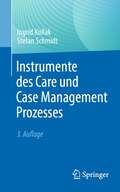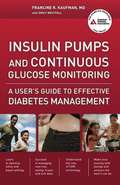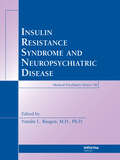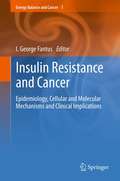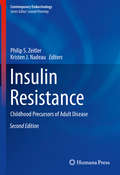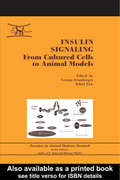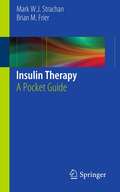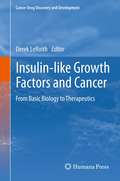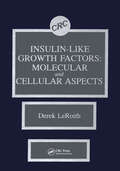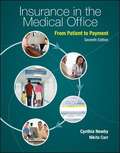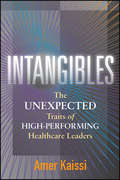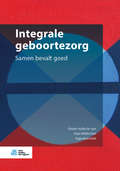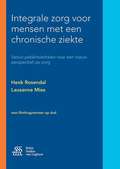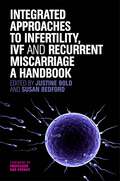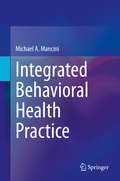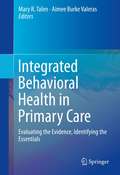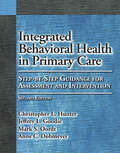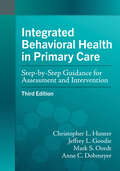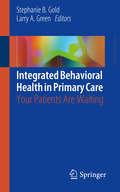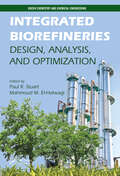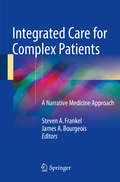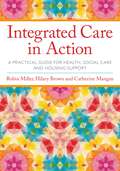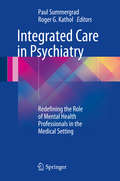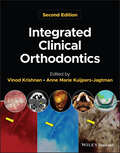- Table View
- List View
Instrumente des Care und Case Management Prozesses
by Stefan Schmidt Ingrid KollakKomplexe Prozesse professionell überblicken und gekonnt zum Ziel führen!Dieses Buch bietet Fachpersonen aus dem Bereich Pflege und Gesundheitsversorgung einen konzentrierten Einblick über die Instrumente des Care und Case Management Prozesses. Lernen Sie die vielschichtigen Abläufe geschickt zu strukturieren und zielorientiert zu steuern. Mit Hilfe der vorgestellten Instrumente gestalten Sie die einzelnen Phasen positiv und decken konkret die Ressourcen und Bedarfe Ihrer Patient*innen auf. Sie ermöglichen eine effiziente interdisziplinäre Arbeit und helfen, die vollbrachten Leistungen zu evaluieren.Die 3. Aufl. ist komplett überarbeitet, neu strukturiert und durch neue Instrumente erweitert.
Insulin Pumps and Continuous Glucose Monitoring
by Francine R. KaufmanA diabetes diagnosis no longer means giving up an active life. New technology, such as insulin pumps and continuous glucose monitors, can help people with both type 1 and type 2 diabetes stay active and flexible and maintain healthy attitudes and lifestyles. Insulin Pumps and Continuous Glucose Monitoring explains how this new technology can dramatically improve care, as well as how to prepare for the physical and psychological challenges that come with these new regimens. It provides a comprehensive medical approach to diabetes management and pump therapy with an appreciation for the real-life challenges and frustrations faced every day by people with diabetes. By offering greater flexibility and control, insulin pumps and continuous glucose monitors are revolutionizing glucose management for people on insulin therapy. Dr. Kaufman's book shows how people with diabetes can use this technology to improve not only their diabetes care, but their lives as well.
Insulin Resistance Syndrome and Neuropsychiatric Disease (Medical Psychiatry Series)
by Natalie L. RasgonThis is the first book of its kind to tie the metabolic syndrome with psychiatric disorders and raise the possibility that common antipsychotic treatments may have this type of adverse effect on patients. Presenting a complete overview and the relationship between insulin resistance syndrome and psychiatric and cognitive disorders, the book will be
Insulin Resistance and Cancer: Epidemiology, Cellular and Molecular Mechanisms and Clinical Implications (Energy Balance and Cancer #1)
by I. George FantusThis book reviews the epidemiological associations between insulin resistance and cancer. This is followed by reviews of animal models which support this relationship and provide insight into potential mechanisms. Several chapters then provide detailed examination of the cellular and molecular changes characterizing the insulin resistant state, such as hyperinsulinemia, abnormal metabolism and hormone signaling, and how these interact with various tumor characteristics. For example some tumors present increased quantities of the fetal form of the insulin receptor, unique regulation of oxidative (Krebs' cycle) metabolism (Warburg effect), as well as mutations in various relevant signaling pathways. Finally, the clinical implications of these data are integrated with considerations of insulin "sensitization" and potential metabolic interventions to prevent and treat cancer. It should be noted that while a number of cancers are associated with obesity the authors here have focused primarily on breast cancer as a key and significant model.
Insulin Resistance: Childhood Precursors of Adult Disease (Contemporary Endocrinology)
by Philip S. Zeitler Kristen J. NadeauNow in a revised and expanded second edition, this unique text presents topics related to insulin resistance in youth and its consequences across the lifespan. In the first section of the book examining epidemiology, the contributors review controversies over the definition of insulin resistance in children and what is known about how insulin resistance in youth differs from adults, the measurement of insulin resistance in youth in the research and clinical settings, and current knowledge regarding the epidemiology of insulin resistance in the pediatric population. The second section of the book explores pathophysiology, including current knowledge of the molecular, metabolic, and physiologic mechanisms of insulin resistance, the unique pathophysiology of pregnancy and puberty, the contributions of the prenatal and early childhood environment to the development of insulin resistance, and adipose and biochemical mediators. This section concludes with discussion of the relationship between insulin resistance and cardiovascular disease and liver disorders. A third section, new to this second edition, explores insulin resistance in unique models: intrauterine growth restriction and girls with polycystic ovary syndrome and metabolic syndrome. The final section of the book explores the concepts of treatment through medications directed at insulin sensitivity, as well as exercise, weight loss medications and consequences of bariatric surgery.Insulin Resistance: Childhood Precursors of Adult Disease, Second Edition provides up-to-date reviews of all of these areas, providing the reader with a current perspective on issues in insulin resistance in youth, an emerging risk factor for disease across the lifespan, that will spur continued interest in the topic on the part of clinicians and researchers, perhaps promoting new points of view and creative approaches to this daunting challenge.
Insulin Signaling: From Cultured Cells to Animal Models
by George Grunberger Yehiel ZickWith contributions from the leading researchers in the field, this volume brings together the latest studies on insulin action and signal transduction to provide a state-of-the-art reference for graduate researchers and students in diabetes and endocrinology. Insulin Signaling is a comprehensive study of the regulation of molecular events by insuli
Insulin Therapy
by Mark W. Strachan Brian M. FrierThe aim of this book is to provide clear and concise information about the safe prescribing of insulin both subcutaneously and intravenously. It provides information on the different types of insulin, the delivery devices, side effects of insulin and, most importantly, on rational dose adjustment.
Insulin-like Growth Factors and Cancer
by Derek LeroithThe book will detail the history, successes, and failures of targeted therapies for cancer, with a particular focus on IGF systems and cancer.
Insulin-like Growth Factors: Molecular and Cellular Aspects
by Derek LeRoithDuring the past decade, the continued interest in insulin-related growth factors has been documented by a plethora of research programs and publications focused on these growth factors. Both molecular and cellular biological techniques have improved and enabled investigators to study the properties of the growth factors in depth.This volume covers the molecular (genetic) aspects of the growth factors, their binding proteins and receptors, as well as those factors affecting their gene transcription and translation. In addition, aspects of the cellular action of these growth factors through their receptors and how this impacts normal cellular function are discussed. The book will provide valuable information for researchers in physiology, biology, endocrinology, and metabolism.
Insurance in the Medical Officer: From Patient to Payment
by Cynthia Newby Nikita CarrThis ensures that offices receive maximum, appropriate reimbursement for services provided. Withoutan effective administrative staff, a medical office would have no cash flow! Insurance in the Medical Office is specifically targeted to Medical Assisting students and addresses the role they play in contributing to the financial success of the medical office.
Intangibles: The Unexpected Traits Of High Performing Healthcare Leaders (ACHE Management)
by Amer KaissiWinner of the 2019 ACHE James A. Hamilton Book of the Year Award! As a leader, is it possible to be both successful and humble? Studies show that today’s emerging leaders not only prioritize achievement over humility but also see the two as mutually exclusive. Does this signal an existential crisis for healthcare—an industry that, at its essence, is supposed to embody humility and compassion?Thankfully, no, according to Intangibles: The Unexpected Traits of High-Performing Healthcare Leaders, which demonstrates that you can embrace humility and still be excellent at your job.The author, a healthcare professor, executive coach and consultant, gleans evidence and insights from researchers, executives, philosophers, and thought leaders. Intangibles is neither a self-help book offering prescriptive answers nor a leadership-guru memoir looking back at a lifetime of lessons learned. Rather, it offers an engaging exploration of evidence-based practices from an array of leaders in different settings.The book’s stories, interviews, and research findings will appeal to readers of every stripe and career stage, from undergraduate students in healthcare administration to early careerists and even seasoned CEOs.Part 1 introduces the four intangible leadership traits: humility, compassion, kindness, and generosity. Part 2 explores each trait in detail, and part 3 tackles the traits through the lenses of gender, age, and self-improvement.Along the way, the book explores many intriguing questions: Is humility viewed as weakness? Can leaders balance kindness with a strong personality? How do men and women differ in their perceptions of these traits? Are there generational differences in how leadership is perceived? Can these characteristics be learned?In the end, Intangibles concludes that high-performance in leadership can be achieved when humility is combined with ambition, and compassion with strength.
Integer Linear Programming in Computational and Systems Biology: An Entry-Level Text and Course
by Dan GusfieldInteger linear programming (ILP) is a versatile modeling and optimization technique that is increasingly used in non-traditional ways in biology, with the potential to transform biological computation. However, few biologists know about it. This how-to and why-do text introduces ILP through the lens of computational and systems biology. It uses in-depth examples from genomics, phylogenetics, RNA, protein folding, network analysis, cancer, ecology, co-evolution, DNA sequencing, sequence analysis, pedigree and sibling inference, haplotyping, and more, to establish the power of ILP. This book aims to teach the logic of modeling and solving problems with ILP, and to teach the practical 'work flow' involved in using ILP in biology. Written for a wide audience, with no biological or computational prerequisites, this book is appropriate for entry-level and advanced courses aimed at biological and computational students, and as a source for specialists. Numerous exercises and accompanying software (in Python and Perl) demonstrate the concepts.
Integrale geboortezorg: Samen bevalt goed
by Hajo Wildschut Inge BoesveldDit boek behandelt de vele aspecten van wetenschappelijk verantwoorde integrale geboortezorg. En laat zien welke eisen eraan gesteld worden. Hierbij is het van belang dat zorgprofessionals over de grenzen van hun eigen discipline heen kijken en samenwerken met collega’s uit andere disciplines.Integrale geboortezorg betekent dat de (aanstaande) ouders en het kind de spil zijn waar de zorg om draait. Integrale geboortezorg betekent ook dat zorgprofessionals over de grenzen van de eigen discipline heen kijken, met het accent op samenwerking. Samenwerking tussen verschillende disciplines die bij het zorgtraject zijn betrokken. Dat traject begint al vóór de bevruchting en loopt door tot het kind twee is.Aan bod komen onder andere positie van de (aanstaande) ouder(s) en het kind, kwaliteit van zorg, risicomanagement, taken en verantwoordelijkheden, omgang met klachten, incidenten, complicaties en calamiteiten, integraal zorgdossier en e-health, financiële aspecten, deskundigheidsbevordering en het belang van interprofessionele samenwerking.Dit boek is bedoeld als een handreiking voor alle zorgprofessionals werkzaam in de geboortezorg. Het maakt nieuwsgierig; het zegt niet hoe het moet, wel hoe het kan.
Integrale zorg voor mensen met een chronische ziekte: Vanuit patiëntverhalen naar een nieuw perspectief op de zorg
by Henk Rosendal Lausanne MiesIk heb moeten leren dat ik als patiënt zeggenschap heb over de manier waarop ik behandeld word. Dat het goed is zelf na te denken over mijn wensen en dat ik aangeef hoe ik wil dat zorgverleners met mij omgaan.' Anke de Jong-Koelé Verhalen van mensen met een chronische ziekte staan centraal, zowel in het leer-werkboek als op de bijbehorende dvd. Uit deze verhalen blijkt dat patiënten geen onderscheid maken tussen zorg en welzijn, en ook niet redeneren vanuit een bestaand (zorg)aanbod. Zij willen vooral leren omgaan met de beperkingen die ze ondervinden in hun dagelijks leven. Zorgprofessionals uit de praktijk hebben in focusgroepen op deze verhalen gereflecteerd om de werkelijke problemen en uitdagingen voor eerstelijnszorg boven tafel te krijgen. Vooral de kwaliteit van leven is belangrijk. Iemands medische situatie is daar slechts een onderdeel van. Hoe kan de zorg zich meer richten op de mens en zijn functioneren, en minder op de aandoeningen? Daarvoor moeten professionals een nieuwe werkwijze aanleren: integraal, kritisch en creatief. Dit leer-werkboek bevat veel materiaal om hiermee te oefenen. 'Standaardoplossingen voor mensen met een chronische ziekte werken niet. Dat laat dit boek helder zien. Voor een goede hulpverlening is een open, kritische blik nodig op het leven van iedere patiënt. En vervolgens creativiteit en samenwerking. Een onmisbaar boek in elke opleiding voor zorg en welzijn.' Prof.dr. A.J.P. Schrijvers, hoogleraar Public Health, UMC Utrecht
Integrated Approaches to Infertility, IVF and Recurrent Miscarriage: A Handbook
by Justine Bold Dian Shepperson Mills Kamran Rostami Deborah Cook Irina Szmelskyj Lisa Attfield Natasha Claire Dunn Professor Gab Kovacs Karen Macgillivray-Fallis Karen Veness Clare Casson Susan Bedford Dr Mohammed Rostami-Nejad Louise CarderA comprehensive integrative handbook on fertility treatment, and Assisted Reproduction Techniques (ART), the book is written by specialist contributors for health professionals and Complementary and Alternative Medicine (CAM) practitioners, and for those seriously considering ART themselves. Integrated approaches to infertility offer both a greater awareness and understanding of the combination of factors that can influence the chances of success when undergoing different types of ART. Leading experts review the evidence and discuss the benefits of different approaches to support the physiological and emotional aspects of fertility and fertility treatment. The book covers everything from identifying and treating conditions that may reduce fertility, including immunological abnormalities and specific male and female factors, to how nutrition, acupuncture, reflexology and yoga can support couples going through assisted reproduction, including helping to improve some immunological aspects. There is also a chapter that looks specifically at support for the over 40's.
Integrated Behavioral Health Practice
by Michael A. ManciniThis valuable resource prepares graduate-level students in social work and other helping professions to provide integrated behavioral health services in community-based health and mental healthcare settings. Responding to the increasing prevalence of behavioral health issues in the general U.S. population and the resulting additional responsibilities for social workers and health professionals, this textbook describes the latest evidence-based practices and interventions for common behavioral health disorders as well as issues related to suicide, violence, substance use, and trauma. Detailed case studies help illustrate the effects of a range of interventions, inviting readers to consider how best to implement behavioral health assessment and treatment practices that are evidence-based, trauma-informed, and recovery-oriented. In addition to outlining integrated behavioral health service models and assessment tools, chapters address specific topics such as: Public health approaches to addressing interpersonal violenceIntersections of social, behavioral, and physical healthAchieving recovery and well-being from behavioral health disordersMotivating clients to achieve and maintain recovery from addictionStage-based treatments for substance use disordersCognitive behavioral approaches to treating anxiety and depressive disordersEvidence-based approaches to treating the effects of trauma and PTSD Integrated Behavioral Health Practice equips graduate students and health professionals alike to provide sensitive and informed interprofessional care for patients and families while consistently engaging in practices that emphasize recovery and well-being.
Integrated Behavioral Health in Primary Care
by Aimee Burke Valeras Mary R. TalenContributed by experts who've developed integrative healthcare initiatives with strengths in the areas of policy and principles, organizational systems, or clinical practice. These contributors will illustrate the concepts and describe the nuts and bolts of their integration initiatives. In the conclusion of each section, the editors will construct a template to systematically evaluate these essential elements. This template will organize the information to help stakeholders compare and contrast the strengths, resources, limitations, and challenges of how each model meets the vision of integrative healthcare. In the concluding section the information in the preceding sections connects to provide a coherent synopsis of the common themes and practices, from the macro to micro levels of care, which foster successful integration of the medical and psychosocial systems.
Integrated Behavioral Health in Primary Care: Step-By-Step Guidance for Assessment and Intervention
by Christopher L. Hunter Dr. Jeffrey L. Goodie Mark S. Oordt Anne C. DobmeyerThis timely new edition of Integrated Behavioral Health in Primary Care brings the reader up to speed with the changing aspects of primary care service delivery in response to the Patient-Centered Medical Home (PCMH), the Triple-Aim health approach, and the Patient Protection and Affordable Care Act. Drawing on research evidence and years of experience, the authors provide practical information and guidance for behavioral health care practitioners who wish to work more effectively in the fast-paced setting of primary care, and provide detailed advice for addressing common health problems such as generalized anxiety disorder, depression, weight issues, sleep problems, cardiovascular disorders, pain disorders, sexual problems, and more. New to this edition are chapters on population health and the PCMH; children, adolescents, and parenting; couples; managing suicide risk; and shared medical appointments.
Integrated Behavioral Health in Primary Care: Step-by-Step Guidance for Assessment and Intervention
by Christopher L. Hunter Dr. Jeffrey L. Goodie Mark S. Oordt Anne C. DobmeyerNow in its third edition, Integrated Behavioral Health in Primary Care details the relevant updates in the field for behavioral health care practitioners and offers targeted clinical assessment and intervention strategies that will meet the future needs of educators, students, and clinicians. Drawing on comprehensive research evidence and the authors&’ decades of clinical experience, this book offers practical guidance for behavioral health care practitioners who want to work more effectively in the fast-paced and complex setting of primary care. Chapters provide an overview of the key foundational concepts and applications of behavioral health within the primary care setting, and detail the competencies required for optimal assessment and intervention outcomes. The authors give detailed, practical advice for addressing common behavioral health concerns including depression, anxiety, health behaviors, pain disorders, substance misuse, and other pertinent problems, as well as special issues such as managing suicidal risk. Key updates to this third edition include: An expanded exploration of core competencies and clinical practice management skills; A review of the neuromatrix theory of pain model, as well as additional important considerations for assessing and treating fibromyalgia and other pain disorders, and; Assessment and intervention guidelines for opioid misuse.
Integrated Behavioral Health in Primary Care: Your Patients Are Waiting
by Stephanie B. Gold Larry A. GreenThis book provides an evidence-based guide for primary care physicians seeking to integrate behavioral health into their practice. This is grounded in the underlying notion that integrating behavioral health and primary care is not an adjustment to practice but a reconstruction of how primary health care is defined and delivered. While some aspects (billing and financing) will be specific to the policy context in the United States, much of the book will contain universal lessons for an approach to integration from a primary care perspective that may be relevant across the globe. This guide is organized to follow a comprehensive approach, derived from lessons learned by early adopters of integration. Dividing the book in this manner creates a unique and natural flow from the “why” of integrating care to a step-by-step approach to achieve integration in a practice. The book includes the case for why integrating behavioral health is important; what integration looks like in practice; and how to transform a practice and grow a team of clinicians to work together to address mental, emotional, and behavioral problems. Each chapter starts with a short preamble to introduce the stage of integration. Each chapter and subchapter would end with a summary box of key messages and a short list of resources (articles, websites, etc) for further information for each topic. Where relevant, chapters additionally include a brief section on application for specific populations (pediatrics, geriatrics, etc). This is an ideal guide for primary care physicians and their medical and administrative teams interested in integrating behavioral health in their practice.
Integrated Biorefineries: Design, Analysis, and Optimization (Green Chemistry and Chemical Engineering)
by Mahmoud M. El-Halwagi Paul R. StuartIntegrated Biorefineries: Design, Analysis, and Optimization examines how to create a competitive edge in biorefinery innovation through integration into existing processes and infrastructure. Leading experts from around the world working in design, synthesis, and optimization of integrated biorefineries present the various aspects of this complex
Integrated Care for Complex Patients: A Narrative Medicine Approach
by Steven A. Frankel James A. BourgeoisThis book presents case-based descriptions of models for the inclusive, multispecialty and multidisciplinary clinical care of complex cases. Cases range from primary care patients with complex systemic medical and psychiatric comorbidity, to those requiring specialty care, to those with potentially terminal illnesses. While each category and case has its unique requirements often necessitating different models of care, the commonalities in approaching complex clinical situations is underscored. Extended case narratives written by the treating physicians, summarizing both the course of clinical care and physicians' reflections on the challenges of managing complex patients, comprise the bulk of the book. Five additional chapters on systems issues associated with care of complex patients, together with a chapter on end of life considerations, a narrative analysis of the physicians reflections about complex patients, and a concluding chapter are prominently included to anchor the case narratives. Written by experts in the field, these descriptions form unique models for assessing and treating complex cases. Integrated Care for Complex Patients is a useful guide for all health practitioners and health administrators who are responsible for clinically complex cases, including physicians in primary care and psychiatry, physician assistants and nurse practitioners, and psychologists.
Integrated Care in Action: A Practical Guide for Health, Social Care and Housing Support
by Robin Miller Hilary Brown Catherine ManganIntegration is now a key expectation within the delivery of health and social care services in the UK and internationally. However, it still remains difficult to achieve and sustain in practice. Based on learning from successful, and unsuccessful, integrated care initiatives, this book is an invaluable guide for those responsible for leading, managing and delivering integrated care across health, social care and housing. Written by an experienced team of researchers who have studied, led and supported integrated care for many years Integrated Care in Practice draws on latest evidence, innovative practice and helpful theory. It provides insights into the common pitfalls that such initiatives can encounter and demonstrates positive approaches to anticipating and responding to such challenges. Throughout, real-case examples are provided, and concepts and models are connected with the realities of day-to-day life for those working within these services. Integrated care is a goal to aspire to - this book helps to explain how we can turn this goal into practical action and positive outcomes.
Integrated Care in Psychiatry
by Paul Summergrad Roger G. KatholIntegrated Care in Psychiatry: Redefining the Role of Mental Health Professionals in the Medical Setting is a landmark title in the field, offering a clear, detailed, and cohesive call by leading experts for coordinated care for patients with concurrent psychiatric and medical conditions. The renowned editors and authors argue that what is slowly occurring, and greatly needed at a faster pace, is nothing less than a sea change in the way that psychiatric care will be delivered. The current, mostly segregated, medical and psychiatric model of care has led to the development of competing medical and psychiatric subcultures that have resulted in a lack of dialog among health providers, administrators, and payers - and thus in less than optimal patient outcomes. To remedy this problem, the book offers a practical, insightful road map to achieving the central tenet of health reform - truly coordinated, patient-centered care where the care experience for the patient, the medical care itself, and the cost outcomes improve as the system changes from fee-for-service to population-based health. An invaluable reference for all clinicians, policy makers, payers, administrators, and others interested in the debate surrounding healthcare systems, Integrated Care in Psychiatry: Redefining the Role of Mental Health Professionals in the Medical Setting is a major contribution to the literature and a gold standard resource.
Integrated Clinical Orthodontics
by Vinod Krishnan Anne Marie Kuijpers-JagtmanIntegrated Clinical Orthodontics Integrates orthodontic diagnosis and treatment into the wider healthcare of the patient to achieve the highest possible standards of care Integrated Clinical Orthodontics offers an overview of clinical orthodontic theory and practice to equip clinicians to take an integrated approach to orthodontic practice. It presents the problems of orthodontics in an interdisciplinary context to describe how the potential complexity of dentofacial problems, the medical histories of patients, and a host of other factors contribute to orthodontic outcomes. The second edition has been expanded and thoroughly updated with new chapters and following an organized approach to the role of the orthodontist as part of a team. Cases in the book include orofacial deformities, sleep disorders, esthetic smile creation and temporomandibular joint problems. Orthodontic diagnosis and treatment are integrated into the wider health of the patient, including orthopedics, neurology, pediatrics, genetics and psychology, and the result is a modern, adaptable approach that places the patient and their needs at its center to achieve the highest possible standard of patient care. Readers of the second edition of Integrated Clinical Orthodontics will also find: New chapters on neuromuscular disorders, customized orthodontics, artificial intelligence, ethics and patient data Expanded content on special care in dentistry Guidance for the clinical interactions between orthodontics and other areas of dentistry and medicine Clinical implications and applications of the integrated approach in every chapter Integrated Clinical Orthodontics is an essential resource for clinical orthodontists and specialists in related medical and dental fields who wish to take the holistic view of orthodontic practice.
